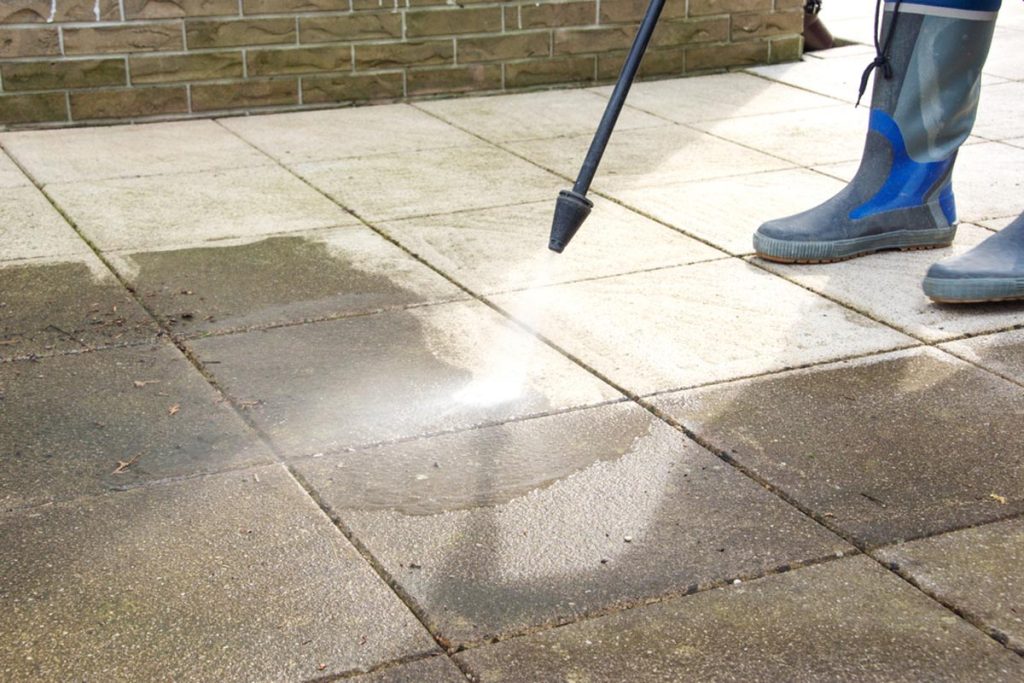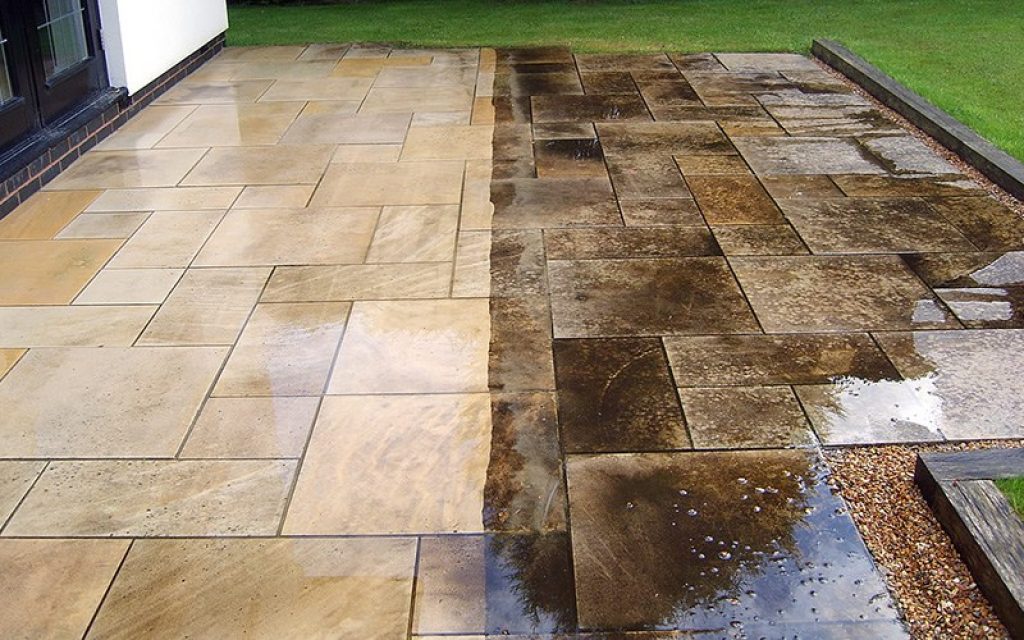




Whether they are made of natural stone, concrete or porcelain stoneware: over time, green deposits form on patio slabs and moss grows in the joints. We show you how to clean patio slabs to free your patio from dirt.
How can patio slabs be cleaned properly?
Compared to wooden terrace, the maintenance effort for patio slabs is manageable. However, after a wet winter or a long period of rain at mild temperatures, algae and moss sometimes grow. When wet, they form a smear layer that not only impairs the appearance but is also very slippery. Therefore, you should remove these coatings in good time.
Both mechanical and chemical cleaning aids are available. To prevent damage to the patio slabs, you should match the cleaning agents to the respective material and, if necessary, test them on an inconspicuous spot beforehand.
Remove coarse dirt from the joints with a special brush or a joint scraper. Take into account the hardness of the bristles to avoid scratching the patio slabs.
The slabs themselves can be cleaned either with a scrubbing brush, water and soft soap or with a pressure washer with a special attachment.
Clean joints and remove coarse dirt
Use a joint brush or a joint scraper to clean the spaces between the patio slabs. If you have a large patio, electric tools or a weed burner can make the job easier. However, for safety reasons, only work with an open flame in mild weather.
Once you have generously removed weeds and moss, you can clean the terrace of coarser dirt with a broom.
How can natural stone patio slabs be cleaned?

Natural stone patio slabs have natural irregularities in their surface, such as cracks and indentations. As a result, natural stones such as sandstone provide a breeding ground for algae and moss. This results in green deposits, which can usually be removed with water and pH-neutral soap.
Dirt on hard natural stones such as granite can be removed with a pressure washer and surface brush. For softer natural stones such as marble or limestone, the high-pressure cleaner is only suitable to a limited extent. We recommend using only the wide jet and keeping a distance of at least 30 cm.
How do you clean concrete patio slabs?

Concrete is durable, but moss and weeds can grow, especially in the joints between the concrete slabs. Small cracks on the surface are also possible due to weathering. To avoid discolouration, we recommend sweeping the terrace regularly so that no leaves remain.
Scrubbing sand can be used to remove coarse dirt. To do this, sweep the fine sand over the patio slabs. The material acts like sandpaper, loosening even dried dirt.
You can clean patio slabs with green deposits of algae with warm water and a scrubbing brush. Alternatively, use paving stone cleaner. Remaining dirt can also be removed carefully with a high-pressure cleaner, as long as you work with moderate pressure and at a certain distance from the slabs.
Use of scrubbing brush and soft soap
Water, biodegradable soft soap and a scrubbing brush are all you need to clean the tiles gently and thoroughly. With this inexpensive variant, you first dissolve the soap in lukewarm water, then moisten the decking and let the mixture soak in for 20 minutes. Then scrub the terrace with the scrubbing brush and let the cleaning agent work for a short time. In the last step, rinse the terrace thoroughly with clear water and allow the stone or concrete slabs to dry thoroughly.
Use of chemical agents
Chemical cleaners, such as green film remover, are usually effective, but not always suitable. Such agents should only be used if they are expressly intended and approved for cleaning natural stone, concrete or porcelain stoneware patios.
Mechanical cleaning agents are more environmentally friendly anyway. With water and a brush, you can usually remove dirt from the patio effectively.
If chemical agents are unavoidable, it is important to follow the safety instructions and the instructions on the packaging and to apply the solution accordingly. After the solution has taken effect, you can treat particularly stubborn stains with a scrubbing brush.
Using the pressure washer
After you have removed coarse dirt, moss and weeds from the joints and slabs, you can start working with the pressure washer. To protect the patio slabs, we recommend that you always use a cleaning attachment. This is because high pressure can permanently damage more porous surfaces such as limestone or sandstone, making them even more susceptible to algae and moss.
With the attachment, you work on the surface like with a hoover.
Without the attachment, the distance between the spray nozzle and the terrace should always be at least 30 cm so as not to stress the material too much. The joints should feel the water pressure particularly gently. Otherwise there is a risk of washing them out.
In addition, it is important to always work with your back to the façade so as not to damage or soil it. Windows and patio doors can be additionally protected by roller blinds or boards.



